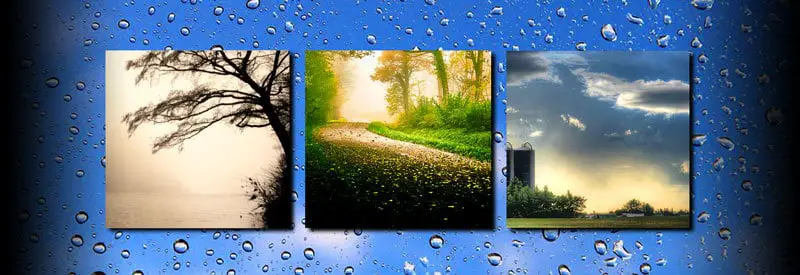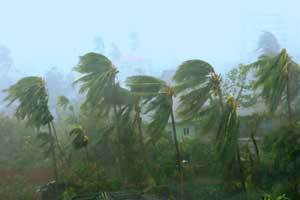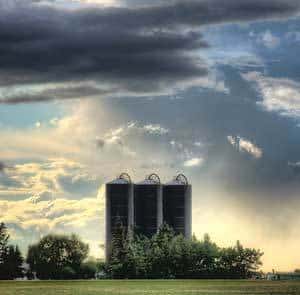Rain Without Clouds – And How A Sunshower Or Serein Can Explain The Mystery

Rain is typically associated with the presence of some cloud formation. But occasionally, rain can fall from a seemingly cloudless sky. This phenomenon is known as a sunshower or serein.
A sunshower is a meteorological occurrence that takes place when rain falls while the sun is shining, with no or very little visible cloud coverage. It usually occurs due to the presence of strong prevailing winds blowing precipitation over long distances or as a result of dissipating rain clouds.
Getting caught off guard by an unsuspected rainshower is an unpleasant experience most of us try and avoid. There has been the odd occasion, though, that one may be outside on a sunny day with not a cloud in sight, only to get hit by light rain or drizzle "out of nowhere."
You probably experienced this very phenomenon at some point in your life. So what did you experience? Was it actual rain falling out of a clear sky, or did you get hit by spray from the neighbor's sprinkler or nearby waterworks as the result of a gust of wind?
You might be surprised to find out that what you experienced might have been a meteorological phenomenon called a sunshower.
What Is A Sunshower?
The term "sunshower" is not that well-known on a global scale since the United States, Australia, United Kingdom, and New Zealand are the only ones widely using it. The phenomenon itself, though, occur throughout the world under different names.
What Is A Sunshower?

A sunshower is a phenomenon that occurs when rain falls while the sun is shining, and few or no clouds seem to be present.
It usually occurs due to the presence of either strong prevailing winds blowing precipitation over long distances or dissipating rain clouds.
The definition may have eluded to the development of precipitation without any clouds present, which is not really the case. In reality, there is no real occurrence of rain without any clouds. We simply don't see them by the time we experience the rainfall.
Sunshowers are often associated with rainbows, especially if the sun is close to the horizon. Since the raindrops get directly exposed to the sunlight during this occurrence, it is much easier for the light to be broken up and refracted by the droplets, resulting in a rainbow.
As you might expect, several theories exist about how sunshowers occur, but two explanations by meteorologists seem to the most logical and widely accepted ones:
- The presence of strong prevailing winds
- Rapidly dissipating clouds
By looking at each of these explanations in detail, one will quickly realize that there might be a relatively simple explanation for what we see as a strange and paradoxical phenomenon.
1) The Presence Of Strong Prevailing Winds
Although you may see a clear sky while you experience a light rain shower, it does not mean that the raindrops did not originate in a cloud system.

A rainshower sometimes occurs during the same time a strong prevailing wind is blowing. Especially when the clouds are of the cumulus type that is situated higher up in the atmosphere than low-lying stratus clouds, rain takes several minutes to reach the ground.
When a strong wind is blowing in the same region from where the raindrops originated, it can carry the rain several miles away from the cloud system.
By the time it reaches the ground, the person experiencing the rain may be completely caught off-guard, as there are no clouds visible in the immediate vicinity that could have warned or indicated the presence of any rain.
In summary, the rain did form in a cloud but was carried off by powerful prevailing winds, only to reach the ground several miles away in an area where no clouds are present.
2) Rapidly Dissipating Clouds
The time it takes for raindrops to leave a cloud and start falling to the ground, to the time it reaches the surface, plays an essential role in the formation of this type of sunshower.
The other ingredient needed to form this type of sunshower is a cloud that is close to dissipating. It means it has very little moisture left to form water droplets, or rising atmospheric temperatures in the cloud make reaching dew point impossible.

When rain falls from this cloud system, almost no moisture is left. Combined with the inability to reach dew point temperature, it means that no further condensation can take place and no more waterdrops can form.
As a result, the cloud starts to dissipate quickly after the last raindrops fell from it. Since the rain takes a couple of minutes to reach the ground, the chances are good that the cloud will have broken up completely by the time you experience the rainfall on the ground.
And as in the first explanation, you may look up to see where this unexpected light shower came from, only to see sunshine and a mostly cloudless sky.
Names and Beliefs Associated With Sunshowers
Although the name may be native to only a few countries, sunshowers occur throughout the world, as already mentioned. The only difference is that each country or culture has its unique name for this event.
Since the phenomenon of rain, while the sun is shining, is such a paradoxical occurrence, different cultures also attach specific beliefs and meanings to a sunshower.
The sheer number of different names and beliefs associated with sunshowers are too numerous to name each one. By providing a shortlist of each, though, you will be able to get an idea of the broad spectrum that exists throughout the world.
Different Names For Sunshowers
In this section, we will look at a few names given to a sunshower from different regions around the globe:
- Twieled Tork: The name used in Malta, which means "a Turkish baby was born."
- Umshado Wezinkawu: The name used in South African Zulu, which means "monkey's wedding."
- Vitterväder: The name used in Sweden.
- Gribnoy Dozhd (грибной дождь): The name used in Russia.
- Mua Bong May: The name used in Vietnam.
- Nagda Paaus: The name used in Marathi.
- Kitsune No Yomeiri: The name used in Japan, which means "the fox's wedding."
I can go on for ages, but you get the idea. It is interesting to note that the majority of these names can be translated into subjects surroundings jackals and weddings. When we look at the beliefs and folklore associated with a sunshower, this will become much more obvious.
Beliefs And Folklore Associated With Sunshowers
The meaning and beliefs different cultures associate with a sunshower are just as numerous as the different names they give the same phenomenon. Here are a few examples:
- In South Africa, there is an Afrikaans saying when a sunshower occurs; "Jakkals trou met wolf se vrou," which translates to "Jackal marries the wolf's wife."
- In Bulgaria, it is common to refer to a "bear getting married" when this event takes place.
- In El Salvador, the people refer to "a deer giving birth."
- In Cuba, there is a saying, "Se está casando la hija del diablo," which translates to "The devil's daughter is getting married" when a sunshower occurs.
- In parts of the United States, it is said that "the devil is beating his wife" during this event.
- In Poland, there is the following saying; "Słońce świeci, deszczyk pada, baba jaga masło składa", which means "a which is busy making butter."
- In Argentina, it means "An old woman is getting married."
- In Korea, the saying goes, "The fox is marrying the tiger" during a sunshower.
- In parts of Pakistan, a sunshower translates to, "One eye jackal's wedding."
It is clear from these few examples that marriage, the jackal, and the devil, are all common themes associated with a sunshower.
What Is Serein And How Is It Relevant?
A sunshower, however, is not the only phenomenon where rain falls while the sun is shining. Serein falls in the same category. But what is serein?
What Is Serein?

Serein is the light rain or drizzle that falls from a clear sky during or after sunset.
The term originated from the French word, "serein," which directly translates to "calm, tranquil, or serene."
Apart from the name and time of day associated with it, serein is no different from a sunshower in any practical terms.
Its existence is also the result of either rapidly dissipating clouds or strong prevailing winds, which is the same way in which a sunshower gets formed, as you saw earlier in this article.
Conclusion
As discussed in this article, you can experience rain while the sun is shining, and little or no clouds are present in your area. But as the post also explains, clouds are always present at the location where the raindrops initially formed.
It is a paradoxical occurrence and can be divisive. Depending on whether you see it from a practical or scientific perspective, you will either believe in the existence of a sunshower (or serein) or dismiss it altogether.
Never miss out again when another interesting and helpful article is released and stay updated, while also receiving helpful tips & information by simply clicking on this link .
Until next time, keep your eye on the weather!

